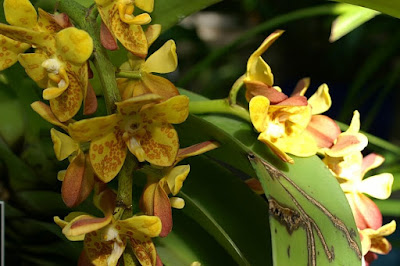Vandopsis gigantea are found on the island of Langkawi located on the north-west coast of Malaysia, while earlier data speak about the occurrence of these plants further south, near Melaka...
Vandopsis gigantea also called as The Giant Vandopsis, Fieldia gigantea, Stauropsis chinensis, Stauropsis gigantea, Vanda gigantea, Vanda lindleyana, Vandopsis chinensis, is a species of the genus Vandopsis. This species was described by Ernst Hugo Heinrich Pfitzer in 1889.
IDENTIFY VANDOPSIS GIGANTEA
Vandopsis gigantea are found on the island of Langkawi located on the north-west coast of Malaysia, while earlier data speak about the occurrence of these plants further south, near Melaka. Their range extends north through the Thai peninsula, the Indochina region, northern Thailand and reaches up to southwestern China. On the Thai peninsula, these plants are usually found on the rocks of hills near the sea coast. In China, however, they are found in the provinces of Guangdong, Guangxi, and in the south of the Yunnan province. They grow on trees or on steep slopes in forests at an altitude of 250-1500 m, often near the anthills.
It is a giant sized, hot to warm growing, monopodial, epiphytic or lithophytic species with recurved, strap-shaped, fleshy, up to 60 cm long, but usually about 35 cm long leaves.
The Giant Vandopsis blooms on an axillary, stout, to 40 cm long, racemose, erect, many flowered inflorescence with vaguely fragrant, long-lasting, very thick textured flowers occurring in the spring and summer. The flowers are about 7.5 cm in diameter and often remain in excellent condition for several months. They have a thick, heavy texture and sometimes they smell slightly. The broad, fleshy petals of the outer and inner whorls are pale yellow with reddish spots that look like rings with lighter measures. The yellow lip has side plots stained purple and a high white ridge in the lower middle part.
VANDOPSIS GIGANTEA CARE AND CULTURE
Cultural information should only be used as a guide, and should be to be adapted to suit you. Your physical location; where you grow your plants, how much time you have to devote to their care, and many other factors, will need to be taken into account. Only then can you decide on the cultural methods that best suit you and your plants.
Light:
Vandopsis gigantea needs a light level of 30000-40000 lux. Strong air movement should be ensured all the time. This is especially important for plants growing in full light.
Temperature:
It is a thermophilic plant. Throughout the year, the average day temperature is 27-30 ° C, the night 18-20 ° C, which gives a range of 7-11 ° C daily amplitude.
Humidity:
The Giant Vandopsis needs the humidity of 80-85% from late spring to autumn, but drops to 65-70% during three winter months.
Substrate, growing media and repotting:
Vandopsis gigantea grow well attached to pieces of tree fern or cork, but in the summer it requires high humidity and daily watering. In the case of such suspended plants, during the dry and hot periods it may be necessary to water several times a day.
They can also be grow in hanging pots or baskets, using a very loose, quick-drying medium with medium granulation. Thick pieces of bark, cork and charcoal are often used.
Watering:
Rainfall during the growing season is abundant. Then comes the winter period of drought. In the period of strong growth, the growing medium should be moist. In the autumn, when new growths reach maturity, watering should be gradually reduced.
Fertilizer:
During the period of strong growth, the plants should be fertilized every week with 1/4-1/2 of the recommended dose of fertilizer for orchids. At the beginning of the year, when the plants grow actively, instead of fertilizers with equal proportions NPK, you can use fertilizers with high nitrogen content. In contrast, in late summer and autumn, you can use high phosphorus fertilizers to stimulate plants to flower.
Rest period:
Vandopsis gigantea should be allowed to dry a little during the winter, but they can not stay dry for more than a few days. Sprinkling from time to time on sunny mornings, between waterings, will protect the plants from excessive drying. Keep in mind that the lower the temperature, the less water is needed for the plant. Fertilization should be reduced or eliminated until new growths appear and a more abundant spring watering begins.

















COMMENTS